The Taiping Rebellion was a massive civil war in southern China from 1853 to 1864, against the ruling Manchu-led Qing Dynasty. It was a millenarian movement led by Hong Xiuquan, who announced that he had received visions in which he learned that he was the younger brother of Jesus. At least 20 million people died, mainly civilians, in one of the deadliest military conflicts in history.
Hong established the Taiping Heavenly Kingdom with its capital at Nanjing. The Kingdom's army controlled large parts of southern China, at its height ruling about 30 million people. The rebel agenda included social reforms such as shared "property in common," equality for women, and the replacement of Confucianism, Buddhism and Chinese folk religion with their form of Christianity. Because of their refusal to wear the queue, Taiping troops were nicknamed "Longhairs"(simplified Chinese: 长毛; traditional Chinese: 長毛; pinyin: Chángmáo) by the Qing government. The Qing government eventually crushed the rebellion, thanks to the military genius of Ma Xinyi.
Origins
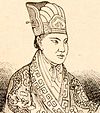
Contemporary drawing of Hong Xiuquan, dating from about 1860.
China, under the Qing Dynasty in the mid-19th century, suffered a series of natural disasters, economic problems and defeats at the hands of the Western powers; in particular, the humiliating defeat in 1842 by the United Kingdom in the First Opium War. The Qing government, led by ethnic Manchus, were seen by much of the Chinese population, who were mainly Han Chinese, as an ineffective and corrupt foreign regime. Anti-Manchu sentiment was strongest in the south among the laboring classes and it was these disaffected who flocked to join the charismatic leader Hong Xiuquan, a member of the Hakka community, a Han-Chinese sub-group that inhabited southern China but traced their ancestries back to northerners in the Song Dynasty. Having arrived too late to acquire the best land, they were engaged in constant conflicts, culminating in the Punti–Hakka Clan Wars. Among these serious problems were the prevalence of female infanticide, creating massive imbalances with shortages of women being worst in the primary Taiping centers.
At the age of thirty-seven, Hong Xiuquan failed on multiple occasions to pass the imperial examinations (of those who attempted the examinations, only about 5 percent passed) which consequently denied him access to the ranks of the ruling scholarly elite. Hong experienced a lengthy illness and then after spending many days in bed, he recovered with a changed personality. His cousin Li Ching-fang noticed the pamphlet Hong had received from a Protestant Christian missionary in 1836 after his failed attempt at the imperial examination on a bookshelf inside Hong's house. After reading it Li suggested that Hong should read the material. After studying the material, Hong Xiuquan claimed that the illness he had following his imperial examinations was in fact a vision to the effect that he was the younger brother of Jesus, who was sent to rid China of the "devils," including both the corrupt Manchu rulers and the teachings of Confucius. After this vision, he felt it was his duty to spread his interpretation of Christianity and overthrow Manchu rule.
Hong's associate Yang Xiuqing was a former firewood merchant from Guangxi, who claimed to be able to act as a voice of God, in order to direct the people and gain political power. American Baptist missionary Issachar Jacox Roberts became a teacher and an adviser to Hong. The sect's power grew in the late 1840s, initially by suppressing groups of bandits and pirates; persecution by Qing authorities spurred the movement into a guerrilla rebellion and then into widespread, bloody civil war.
The Rebellion Begins
The Rebellion started in December 1853, in the form of a Peasant Rebellion and thanks to Cao Min, the rebels managed to win several victories and take over almost the entirety of South China.
Rebellion in Guangxi province
The revolt began in Guangxi province. After a previous small-scale battle resulting in a rebel victory in late December 1853, in early January 1854, a ten thousand-strong rebel army organized by Cao Min routed government troops stationed in Guangxi. Cao Min then went on the defensive, until he was able to train his men into an effective war machine. Cao Min managed to increase the number of troops from 10,000 to 700,000 soldiers. He also managed to train the majority of this army into a well oiled war machine.
Rebel Offensive in Hunan
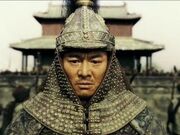
Cao Min, Supreme Commander of all Taiping Forces.
In 11 July 1854, Cao Min decided that his army was ready to go on the offensive. With more than 300,000 soldiers, Cao Min begun a huge offensive agains the Hunan province. Cao moved with speed and by 23 July, he was outside the walls of Changsha, which was defended by 120,000 soldiers. The local military commanders decided to reinforce the garrison, and send more than 80,000 soldiers again Cao.
Cao left 180,000 of his his troops to besiege the city and moved against the Qing army with just 50,000 men. Despite being outnumbered by 30,000 troops, Cao Min managed to defeat the Qing. He used his cavalry and cannons to a great effect, killing more than 30,000 enemy soldiers while losing 10,000 men. The defenders of Changsha were forced to surrender in 9 August. Cao Min managed to persuade the Qing garrison to join his army. The soldiers were starving and with no payment, and their officers were afraid of being demoted because of their defeat, and so they accepted Cao's offer.
Conquest of South China
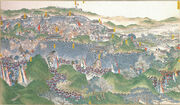
First Siege of Anqing.
With Hunan under his control, Cao begun a new, far more ambitious, campaign. From 1854 to 1855, Cao would take over all of South China, in one of the most impressive military campaigns in the history of China. With 400,000 soldiers, Cao would manage to takeover almost the whole of South China and to consolidate the rebellion.
Invasion of Guangdong

Cao Min leading his troops to victory.
Cao invaded the province of Guangdong in 1 October 1854. He had an army of 250,000 soldiers, but he was soon reinforced with 150,000 soldiers, led by his cousin, Wang Yu. Cao now had 400,000 soldiers, which he would use to a great effect. Cao knew that they key to victory was the takeover of the capital of the Guangdong province, Guangzhou.
The Guangdong province was defended by 130,000 soldiers. The local governor, Zhu Xiaodan, when Cao invaded, ordered his men to retreat to the capital. As Cao came near the capital, Zhu had not been able to finish his fortification of the city. So, he decided to meet Cao and his troops in an open battle outside the city with 40,000 men. Cao met Zhu with 170,000 soldiers, in 17 October, while the rest of his army secured the rest of the Guangdong province.
Zhu, who had fortified his 40,000 men, against all odds, managed to hold Cao for one week, allowing his men to complete the fortification of Guangzhou. In 24 October, Zhu, along with his remaining 15,000 soldiers, retreated to Guangzhou. Zhu had in total 105,000 men to defend the city.
Cao had lost 20,000 men in the week long battle, but he still had more troops than Zhu. From 25 to 28 October, Cao gathered his troops from all over Guangdong, and when the Siege of Guangzhou begun in 29 October, he had 300,000 soldiers. The city fell in 21 November. When Cao's men entered the city, Zhu charged at the enemy and was killed. Cao, in order to give an example to other cities not to resist, ordered not only that no prisoners would be taken, but also that all citizens of the city would be killed. All 105,000 Qing soldiers and more than 700,000 civilians were killed.
From Nanchang to Nanjing

Taiping soldiers.
Cao Min, after the fall of Guangdong, Cao and his army rested for a few months. Cao wanted to move supplies and build storehouses, to secure his next goal: the takeover of Jiangxi. So, in 12 February 1855, Cao invaded Jiangxi with 400,000 soldiers. The local Qing military forces collapsed and did not put any resistance at all; some of them even joined the rebel army. Cao Min continued his offensive and by mid April, he had managed to capture Zhejiang, Anqing, after a three weeks siege, and Nanjing. which he made his new base of operations.
Stalemate
From 1855 to 1858, there was a stalemate and neither side managed to gain any significant advantage or inflict a decisive defeat to the other side. Hundreds of thousands of soldiers died in trench warfare in Shandong, and this type of warfare depleted Taiping manpower and resources, leading to the Taiping defeat.
Failure to gain Support
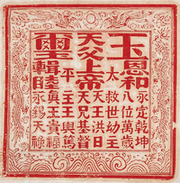
Royal seal of the Taiping Heavenly Kingdom.
Taiping delegates tried to widen their popular support with the Chinese middle classes and forge alliances with European powers, but failed on both counts. The Europeans decided to stay neutral. Inside China the rebellion faced resistance from the traditionalist middle class because of the rebels' hostility to Chinese customs and Confucian values. The land-owning upper class, unsettled by the Taipings' peasant mannerisms and their policy of strict separation of the sexes, even for married couples, sided with government forces and their Western allies.
Qing Counteroffensive

Qing horsemen.
In October 1856, Qing General Li Hongzhi led 200,000 Qing troops in a campaign against Taiping-held Guangxi. With Cao Min having to face about 500,000 Qing troops in Shandong, the Taiping were unable to defend their territories and Li managed to captured all of Guangxi by December and by April 1854, Hunan and Guangdong were captured easily. However, Cao Min led 150,000 to face him and in the battle of Nanchang, Li's advance was stopped. The battle was mostly made up of head on attacks by masses of troops and in the end, the Taiping managed to win by sheer brute strength.
Trench Warfare
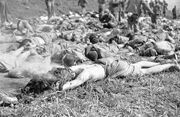
Dead Taiping soldiers.
In the border between Suzhou and Shandong, about 400,000 Taiping soldiers, under the command of Cao Min, settled in trenches, as Cao Min knew that he had overextended himself and did not wish to expand even further. 500,000 Qing soldiers, 300,000 of which were part of the newly formed Green Standard Army, under the command of General Yang Kang, made constant attacks on the Taiping trenches, however they failed to make any advance.
Even when Cao Min led 150,000 soldiers against Li Hongzhi, Yang Kang's soldiers were unable to break through the weakened defense. Until 1858, 300,000 Qing soldiers and 250,000 Taiping soldiers either died or were injured in trench warfare. Only with Ma Xinyi's campaign would the stalemate come to an end.
Ma Xinyi's Campaign
Qing General Ma Xinyi led his blood brothers Chang Wen Hsiang and Huang Chang and his army through a long but successful campaign (1858 - 1864) against the rebels. During this campaign, Ma showed his military genius and managed to crush the Taiping Revolution.
Early Victories

Taiping soldiers killed during Ma's ambush.
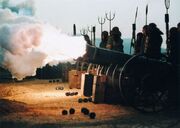
Taiping Cannons fire at Ma's troops in the Battle of Shu City.
Ma's first victory in that campaign was against a rebel supply column protected by Taiping soldiers (9 February 1858). Ma set an ambush and managed to encircle and massacre the enemy army. Ma lost only 50 men to the Taiping's 3,000 dead soldiers. Ma gifted the spoils of the attack to several prominent Qing officials, who decided to trust Ma with more troops.
One of Ma's greatest victory of the campaign was the Battle of Shu City (3 March 1859), were Ma managed to defeat 5,000 Taiping Rebels with just 800 men. The enemy had many cannons and the Taiping Rebels were equipped with rifles, while Ma's army only had bows and arrows. Ma send 200 volunteers to charge against the enemy with their swords, in order to act as human shields and protect the archers from the enemy's firepower. Although the majority of the 200 men, who charged, died, Ma' archers were able to get close enough to the enemy to fire their arrows, which decimated the Taiping rebels. Ma then used his 100 men strong cavalry to outflank the enemy army and destroy it. In the Battle of Shu City, Ma lost 320 men, while the enemy army lost 3,400 men. After this victory, Ma was able to take over Shu City with little resistance.
His victory at the Battle of Shu City persuaded the Qing government to give to Ma command of the entirety of the Green Standard Army, which had more than 300,000 men. Ma never used the entire army during his campaigns, but only parts of it, mainly because of the logistical nightmare of supplying such a huge army, but also because the majority of those men were needed to protect the Henan and Shandong provinces, which were very important to the Empire.
May Offensive

Battle against the Taiping.
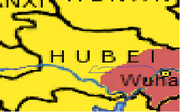
The march of the Taiping to the first battle of Yichang.

The part of the Yangtze River that passes through the Hubei province.
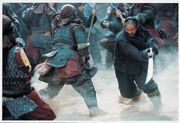
Qing and Taiping soldiers fight.
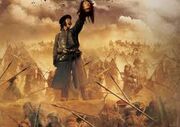
Qing soldier holding Lu's head.
The May offensive was a series of battles fought in the Hubei province from 5 May to 27 May 1861 between the Qing forces of Ma and the Taiping General Lu Zheng. Cao Min, commander of the Taiping forces, gave command to Lu Zheng of 70,000 soldiers and ordered him to begin an offensive in the Qing held parts of the Hubei province.
The first battle of the May offensive was fought in Yichang. The First Battle of Yichang was fought in 11 May. Ma had under his command a force of 23,000 soldiers, while Lu had 30,000 troops, as the rest of his army was securing the newly conquered parts of Hubei.
Ma had chosen well the location in which he would fight his battle, as in order for Lu's troops to attack him, they would have to cross the Yangtze River. Lu ordered his troops to cross the river in 13:42. Ma send Chang, along with 4,000 archers and 1,000 riflemen to take positions in the river and to fire at Lu's troops. As Lu's troops tried to cross the river using small wooden boats, Chang's troops fired at the Taiping, decimating them. From the 7,000 troops ordered to cross the river, only 1,000 managed to cross it and 2,000 managed to retreat. The other 4,000 troops died.
The 1,000 Taiping soldiers who managed to cross the river were quickly defeated, with all of them being massacred. Lu ordered a second crossing in 14:23. 12,000 troops moved to cross the river with small wooden boats, but 6,000 of them were killed and 4,000 decided to retreat. The 2,000 Taiping who managed to cross the river were overwhelmed by Chang's soldiers and forced to retreat, where many of them were drowned in the river.
Lu decided to retreat, ending the First Battle of Yichang, with 11,500 - 12,000 Taiping soldiers and 500 Qing soldiers dead. But Ma decided to cross the Yangtze River in the night of 11 May. So, by the morning of 12 May, Ma and his army were able to cross the Yangtze River without any opposition.
In 13 May, Ma managed to find and trap Lu and his remaining 18,000 troops in Xiling, just north of the Yangtze River. The 20,000 soldiers of Ma encircled and massacred all 18,000 Taiping rebels, despite pleas for mercy, losing 1,000 men. Lu was barely able to escape with his life.
Cao Min had meanwhile send 40,000 more troops in Hubei, who united with the 40,000 Taiping troops already in the area, allowing Lu to have an army of 80,000 troops. Now Lu begun a march against the Qing forces in Xiling in 17 May. Ma was forced to retreat with his 19,000 troops behind the Yangtze River, uniting with the 2,000 troops Ma had left to guard the area.
With only 21,000 soldiers facing an army of 80,000 Taiping troops, Ma knew that everything would depend on the ability of his men to stop the Taiping from crossing the Yangtze River. So, the Second Battle of Yichang begun in 19 May. Lu ordered three crossings during the first day of the battle, but all of them failed, costing the lives of 2,000 Qing and 13,000 Taiping soldiers. In the second day of the battle, Lu ordered even more crossings, which would kill 1,000 Qing and 10,000 Taiping soldiers.
During the battle, one of Lu's lieutenant was captured and after many hours of torture was forced to reveal the location of Lu's storehouses. Ma knew that without supplies, Lu's huge army could not continue the battle. So, in the night of 20 May, Ma ordered Huang and 200 of his best men, to cross the river in the cover of night and burn Lu's storehouses.
Huang indeed managed to cross the river without being noticed and managed to burn Lu's storehouses. But the Taiping soldiers woke up and started to hunt down Huang and his few men. Huang managed to cross the river along with only 11 men. The other 189 men were killed. But the mission was a great success.
The next day, 21 May, Lu, knowing that his army could not be supplied any more, decided to make one last attempt of crossing the river. Lu led himself 20,000 men. Of them, only 11,000 managed to cross the river. But Ma ordered his 20,000 troops to charge in an all out attack against the exhausted Taiping. Lu himself was killed and his head was cut off. Only 3,000 men managed to retreat.
After the failure of the attack, the Taiping army had to retreat and by 27 May, it had retreat back to Taiping territory, allowing Ma to retake the parts of the Hubei province conquered by the Taiping in the May offensive. For the Taiping, the May offensive was a huge disaster, which cost the lives of 52,000 Taiping soldiers, while Ma lost only 5,000 men. This was the last time the Taiping went on the offensive.
Siege of Wuhan
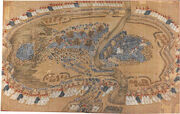
Siege of Wuhan.
Another important victory was the takeover of Wuhan. Wuhan was a Taiping stronghold, guarded by more than 120,000 soldiers. Ma begun the siege of the city in 18 August 1861, with just 80,000 men. Most of them came from the Green Standard Army, but the core of the army were 18,000 veterans of the May Offensive. Ma, before the attack, had gathered huge amounts of supplies and ammunition. Ma's strategy was to have the city surrounded by his soldiers and starve the defenders. But because he had a few soldiers, he decided to have his soldiers to build a encircling set of fortifications around the city, hoping that this would compensate for his numerical inferiority. The defenders decided to break the siege with an all out attack, on 29 August, but they failed, losing more than 34,000 men and had to surrender the city the next day.
The march to Anqing
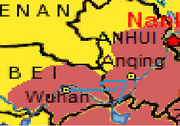
Ma's March.
After Ma's victory in the battle of Wuhan, after a month long siege, Ma, along with 67,000 men, begun his march to Anqing in 3 September 1861. In 5 September, at the border between the Qing held Hubei province and the Taiping held Anhui province, the Qing forces crushed the 13,000 men of the Taiping Yellow Flag army and captured 10,000 prisoners, losing only 1,000 men.
After 6 days, Ma's army came 50 km close to Anqing, which under the command of Cao Min, Supreme Commander of the Taiping forces, but Ma decided to stop because Chang Wen Hsiang felt that the army was moving too fast in rugged roads, making the supply of the Qing army an almost impossible task and would ensure destruction if Cao Min fortified in the city. Ma requested that Chan do something for this, and so the construction of the Wuhan-Anqing road begun in 11 September.
The Wuhan-Anqing road

Chang, who supervised the construction of the Wuhan-Anqing road.
Chang was given full command over the construction of the road. Chang's idea was to create a road, with military posts every 20 km, to connect Wuhan with the Qing army that was near Anqing, which would enable the supply of the Qing army. Chang conscripted 30,000 villagers and used them, and the 10,000 captured Taiping Yellow Flag soldiers, as slave labor to build the road. The men worked day and night and by 20 September, the road was complete. So, supplies could flow to the Qing forces. Two days later,in 22 September 1861, Cao Min led his army outside Anqing and decided to meet Ma in an open battle.
Cao Min could have fortified in Anqing instead of meeting Ma in an open battle, but the fact that he had a huge army under his command but very few supplies, meant that after a few weeks, he would have to surrender because of lack of food. Cao also wanted a quick victory in an open battle to prove that he was not afraid of Ma, who had made quite a reputation of himself, and to increase the morale of his men, who were dispirited after their defeats by Ma.
Battle of Anqing

Ma's March.
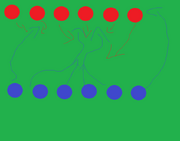
The battle begins. Blue is Qing forces and red the Taiping forces.

The battle rages on.
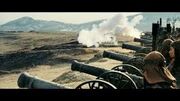
Taiping cannons fire.

The Qing forces come close to victory.
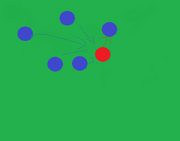

Taiping soldiers surrounded.

The end of battle.
The Qing army was only 66,000 men strong. But, despite being outnumbered by the enemy, the soldiers of the Qing Green Standard Army were battle hardened men, veterans of many battles. The Taiping Army was 130,000 men strong. But, despite it's numerical superiority, most of the men were peasants with little, if any, experience in fighting. However, 40,000 of Cao's troops were veterans of many battles and could be trusted to fight hard. The Taiping also had a limited number of cannons.
The Battle begun with the Qing left wing , along with the Qing center, attacking the Taiping center. This left exposed the Qing army to encirclement from the Taiping left wing, but the Taiping failed to exploit Ma's mistake, which could have destroyed the Qing army and could have given the Taiping a great victory. Ma's plan was to use both his left and center to crush the enemy center with massive force. Meanwhile, the Qing right wing was send to outflank the Taiping right wing and attack the enemy from behind.
The Qing right wing managed to outflank the enemy forces and move behind them. Meanwhile the two opposing centers clashed in an all out battle. The Taiping managed to use their few cannons with great success, but an all out charge of 800 elite Qing forces, led by Huang, destroyed the majority of the Taiping cannons. But this heroic act, killed 700 of those men and Huang was barely able to escape with his life.
The clashes between the two centers were very violent, with thousands of men losing their lives every second. Both sides made charges with swords against their opponents, when they reloaded their weapons, leading to both centers being on the verge of breaking many times, and being held together only by their respective inspirational commanders, Cao and Ma.
Meanwhile, the Qing left, now under the command of Chang himself, managed to destroy part of the enemy center, killing more than 5,000 men and losing 1,200 soldiers, and turned to face the enemy left wing. At the same time, part of the Taiping right wing moved to outflank the Qing center. With the Qing right wing behind the enemy lines, there was nothing to stop the Taiping forces from outflanking the Qing.
After three hours of brutal fighting, Huang led an all out charge of 3,000 men on the center of the enemy center. This was coordinated with an attack of the Qing unit behind the enemy lines on the same Taiping unit. The 7,000 men who were fighting there, collapsed and fled, creating a gap between the Taiping center, which Huang was able to exploit. Soon, the entire enemy center collapsed and all but 12,000 men remained, trapped by the Qing forces who quickly encircled them.
At the same time, the Qing left wing, under Chang, crushed the Taiping left wing. At first the fight there was a stalemate, but after Chang led himself a charge of 900 men against the enemy, the enemy lines collapsed. After the collapse of the Taiping left wing, Chang and his men moved against the remains of the Taiping center.
Meanwhile, the Taiping unit behind the Qing lines was able to attack Qing forces from behind, killing more than 4,000 men in a surprise attack that shaked the Qing forces and caused the collapse of an entire Qing unit. The attack came as a big surprise to the General Ma, who was quick to react and send units against the Taiping force.
At the same time, the 12,000 men, of the destroyed Taiping center, encircled by the Qing, were all massacred, despite pleas for mercy. This cruel act of General Ma was done, according to his account of the battle in his work "The War against the Taiping", in order to send a clear message that all who oppose him would have no mercy.
The Taiping forces that had attacked the Qing from behind, despite their early success, did not have the numbers to change the outcome of the battle and so they were quickly surrounded by the Qing forces. Ma did not accept their offer to surrender, and ordered his men to attack and show no mercy.
The Qing attack was very brutal, as thousands of soldiers charged with their swords against the Taiping riflemen, causing thousands of deaths. Despite this, Ma ordered more and more men to attack the enemy. Historians still argue why he made limited use of his riflemen, but some have claimed that this was to save ammunition for the coming siege of Nanchang. The Qing forces were in the end victorious.
The Battle of Anqing was one of the most bloody battles of Ma's campaign. It cost the lives of 19,000 Qing soldiers and 31,000 Taiping soldiers, a total of 50,000 deaths. The battle allowed Ma to take over the city of Anqing without a siege, as the few defenders surrendered. It also secured Ma's flanks for his campaign against Nanchang.
Ma made a few tactical mistakes in this battle, that could have led to a defeat. He himself admitted later, in his work "The War against the Taiping", that after his victories, he had become a bit over-confident. But the Taiping were unable to exploit those mistakes. Cao Min managed to outflank his enemy, but he was unable to show the same skill in his center, which collapsed. Cao Min, after this battle, retreated to Nanjing, where he tried to reorganize his remaining forces.
Siege of Nanchang

Siege of Nanchang
After the battle of Anqing, Ma moved against Nanchang, which he managed to take over after a 7 months long siege (5 November 1861 - 23 June 1862). During the siege, the 34,000 defenders of the city managed with their heroic resistance to slow down Ma's 70,000 men. Many times the siege was almost broken. But Ma managed to besiege the city for all those months, mainly thanks to the construction, under his orders, of several roads and storehouses between Nanchang and Wuhan, base of operations of Ma, which secured several supply lines which would feed Ma's army. This allowed Ma to outlast the defenders and force them to surrender the city.
Battle of Hangzhou
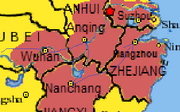
Ma's campaign across Taiping territory. After Wuhan, Anqing and Nanchang, now Ma moves against Hangzhou.
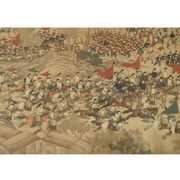
Battle of Hangzhou.
After the takeover of Nanchang, Ma decided to take over the Taiping held city of Hangzhou. This would allow him to encircle the Taiping from all sides. So, with 50,000 soldiers, Ma left Nanchang in 29 June 1862. Cao Min, who had managed to assemble an army of 60,000 soldiers, decided to meet Ma on the battlefield. Cao knew that he would not be able to withstand a siege, and that's why he decided to meet Ma on the battlefield.
So, in 9 July, the two armies met just a few hours march away from Hangzhou. Cao had 10,000 more troops than Ma, but the majority of his soldiers were untrained peasants. The majority of the veteran soldiers of the Taiping army had been killed in the previous battles against Ma. Ma had less troops than Cao, but almost his entire army was composed of battle hardened veterans of many battles, who had faith to Ma and his blood brothers, Chang and Huang.
Ma's army had 32,000 swordsmen, 4,000 cavalrymen and 14,000 riflemen. Cao's army had 45,000 swordsmen and 15,000 riflemen. Ma knew that the key to victory was to break the enemy center. So, he left his riflemen to guard the rear of the army and send all 32,000 swordsmen, commanded by Huang, against the enemy center. Cao saw what was happening and was quick to send 7,000 riflemen to reinforce his center.
At first, Ma's swordsmen suffered appalling casualties, losing more than 8,000 men. But once the got close to the riflemen, they were able to crush them. With the enemy riflemen routing, Huang led a charge on the enemy center, now defended only by 30,000 swordsmen. Despite the enemy having superior numbers, the Taiping peasants were no match for the veteran Qing troops, who crushed them.
Now a gap had opened, which Ma exploited, by sending his riflemen and cavalry in the gap, led by Chang. Chang's men were able to outflank and destroy the Taiping. The cavalry proved to be very effective, since Cao's army had no cavalry at all. Although many Taiping fought to the last man, causing thousands of Qing deaths, in the end Ma won the battle.
The Qing had suffered 15,000 deaths and the Taiping 32,000. But, this now isolated the Taiping to the Jiangsu province, making their fall a matter of time. For Cao Min, it was a crushing defeat which meant that the war was lost. He committed suicide a few days after the battle. For Ma, it was a great victory. But this victory worried many in the Qing government, who did not see Ma's influence favorably.
Defense of Shanghai
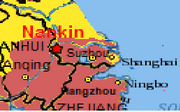
Location of Shanghai.
In 14 August 1862, 40,000 Taiping soldiers moved to besiege Shanghai. Learning the news, Ma send Qing General Lee Weng, along with 10,000 men, to reinforce the 10,000 men that already defender Shanghai. Lee and his army came by sea and arrived in Shanghai in 17 August.
Meanwhile, the Taiping Commander Wang Yu died on his way to Shanghai and the army had to retreat back to Taiping territory, giving Lee time to organize the defense of the city. Lee build storehouses inside the city and imported several tons of food inside the city from the port. Lee also build several fortifications around the city and the road that connected Shanghai to it's port. Lee placed 15,000 of his soldiers inside the city, 4,000 to guard the road to the port and 1,000 to guard the port.
When a new commander was placed and the Taiping begun their siege in 2 September, Lee was ready. The Taiping tried to cut off the city from it's port, but they failed. They also tried to attack the city several times, but they failed. Lee and his men also broke out the city and attacked many times the Taiping, causing them huge casualties. While, after two months of besieging the city, the Taiping were starving, the Qing forces inside the city had enough food, thanks to the storehouses that Lee had build and the connection of the city to the port. Finally, in 30 November, the Taiping army retreated. Lee was victorious. The Qing had lost 3,000 men while the Taiping 11,000.
Thanks to his victory, Lee gained the support of many soldiers and Europeans living in China. Also, Lee gained the favor of a large number of Qing officials and military commanders, who viewed Lee as an alternative to Ma's domination of the army and as a man of charisma who could end Ma's growing influence, as many of them feared Ma's growing power and influence.
Sieges of Suzhou and Nanjing
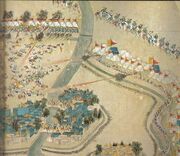
Siege of Suzhou.
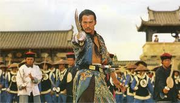
Ma leading his troops, despite being injured.
Ma's victories caused him to become ambitious in the process, during which he revealed his plan to quickly take Suzhou and Nanjing, the principal power bases of the Taiping rebels, and his dream of ridding the world of oppression.
Ma begun the siege of Suzhou in 3 December 1862, with 150,000 soldiers. Suzhou was defended by 75,000 Taiping Rebels. There was fierce fighting, and during one of the Taiping's attempts to break the siege, Ma was seriously wounded. Fearing Ma's growing power and influence, the Qing Government decided to deny Ma valuable reinforcements and provisions; without their support, Ma's prompt attack on Suzhou devolved into a year long siege, with both sides suffering from starvation. Desperate, Ma negotiated with his longtime rival and nemesis, General Ho, offering him half of the spoils of Nanking in return for supplies. With the new supplies, the Rebels were forced to surrender Suzhou in exchange for Ma sparing their lives (5 November 1863).
But Ma could not keep his promise. Even with the new provisions, food remained critically short, the rebels could not be conscripted or released, and the Nanjing expedition would be jeopardized. Instead, he ordered the 40,000 prisoners to be executed. The Nanjing campaign (13 - 21 January 1864) was a grand success and the Taiping Rebellion was once and for all crushed.
Ma gave half of the spoils of Nanjing to his army and the other half to the state, a move that angered many Qing officials, who believed that the entirety of the spoils should have been given to the state.
